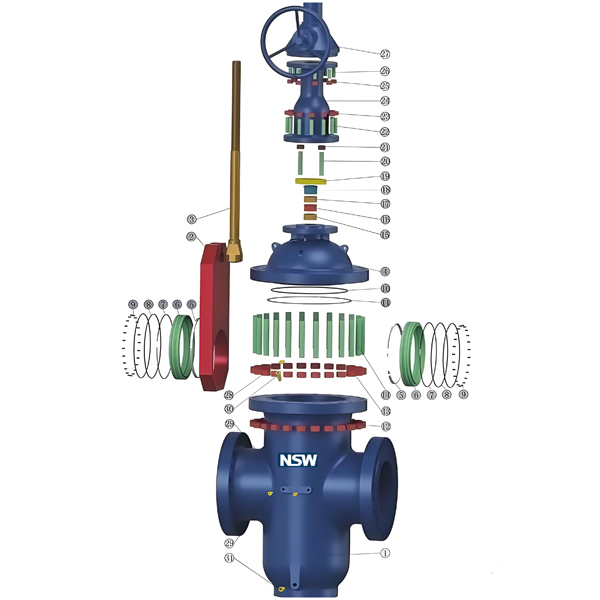What is a Parallel Slide Gate Valve
A Parallel Slide Gate Valve is a sliding valve that controls opening/closing via parallel gate discs. Its closure member (gate disc) features highly polished, flat sealing surfaces that tightly mate with the seat, primarily used to shut off or connect media flow.

Working Principle
The parallel slide gate valve uses a dual-parallel-disc structure. The drive mechanism moves the gate vertically to open/close the fluid path. The gate has a bore equal to the pipe’s inner diameter. Rotating the handwheel or activating the actuator raises/lowers the stem and gate. When the gate bore aligns with the pipeline, fluid flows (valve open). When the gate blocks the flow path (bore retracted into the valve chamber), the valve closes.
Key Components of Parallel Slide Gate Valves
Valve Body & Gate Disc
The body is cast or forged from carbon steel, stainless steel, etc., housing parallel gate discs. Dual-disc design enhances sealing. Vertical disc movement controls flow.
Stem & Sealing Assembly
The stem (alloy/stainless steel) connects to the gate via threads. Sealing components include hardfaced alloy seats, PTFE, or graphite rings ensuring bidirectional sealing.
Drive Mechanism
Actuators comply with API 6D standards, supporting manual, electric, or pneumatic operation. Explosion-proof options available.
Sealing Structure
Features floating seats with pre-loading for bidirectional sealing. Materials: reinforced graphite, PTFE.
Other Critical Components
Yoke Sleeve: Aluminum bronze reduces operating torque.
Seat Ring: Welded for easy maintenance.
Vented vs. Non-Vented Parallel Slide Gate Valves
Core differences lie in structure, function, and application. Vented valves have a hole for pressure relief, pigging, and seat protection in long pipelines. Non-vented valves suit sealed systems without pigging needs.
Structural & Functional Differences
• Vent Hole Design:
Vented: Hole (equal to nominal size) in lower disc. Fully open = hole aligns with seat for flow/pressure relief.
Non-Vented: No hole. Seat groove exposed to media when open.
• Seal Protection:
Vented: Hole always protects seats from direct media erosion, extending lifespan.
Non-Vented: Seats may erode when open; lower reliability.
Application Scenarios
| Comparison Factor | Vented Parallel Slide Gate Valve | Non-Vented Parallel Slide Gate Valve |
|---|---|---|
| Typical Use | Oil/gas trunk lines, piggable pipelines | Power plant piping, pump inlets/outlets |
| Pigging Capability | Supports pigging operations | Cannot be pigged |
| Operating Effort | Low (pressure relief reduces cavity pressure) | Higher operating resistance |
Performance Advantages
• Pressure Relief: Vents cavity pressure upstream, preventing overpressure from media expansion.
• Flow Efficiency: Low pressure drop with smooth flow path (ideal for crude oil, natural gas).
• Maintenance: Pigging clears pipe deposits, reducing downtime.
Structural Features
• Sealing Structure: O-ring seals + pre-loaded floating seats enable bidirectional sealing. Operating torque is 50% lower than standard valves.
• Packing Structure: Self-sealing packing requires minimal adjustment. Light operation & reliable sealing. Auxiliary grease injection ensures zero leakage.
• Flow Path Design: Full-bore straight flow path minimizes pressure loss. Supports pipeline pigging.
• Protection: Fully enclosed structure for all-weather operation.
• Pressure Relief Device: Prevents internal overpressure damage.
• Classification:
By Drive: Manual, Pneumatic, Electric.
By Function: Vented, Non-Vented, Oilfield, Pipeline, Gas.
Application Fields
→ Oil & Gas: Mainline valves for crude/natural gas transmission (up to 15.0MPa). Used in blowdown systems & storage. Complies with API 6D.
→ Chemical Industry: Controls corrosive media (acids, slurries) using PTFE/graphite seals.
→ Power Industry: Manages cooling water/steam flow in thermal, nuclear & hydro plants. Optimizes energy efficiency.
→ Municipal & Environmental: Controls wastewater/gas in treatment/discharge systems. Used in water supply/drainage.
→ Other Industries: High-purity metal transfer (metallurgy), sterile media isolation (pharma), sanitary fluid control (food).
Advantages & Disadvantages
Advantages
1. Low Flow Resistance: Straight full-bore design ≈ resistance of short pipe section. High flow capacity.
2. Excellent Sealing: Dual-sealing discs (metal + soft seat composite) ensure leak-tight closure. Handles pressure/temperature fluctuations.
3. Simple Structure: Easy manufacturing & maintenance. Low lifecycle cost.
4. Wear Resistance: Hard-faced seats extend service life in abrasive media.
5. Wide Applicability: Suits diverse media (-196°C cryogenic to +550°C steam) – crude, gas, acids, slurries.
6. Low Operating Torque: Effortless manual operation.
7. Bidirectional Sealing: Zero-leakage security.
Disadvantages
1. Not for Flow Throttling: Only for ON/OFF service. Partial opening erodes seats.
2. Poor Flow Control Sensitivity: Effective flow control only near 50% open position.
3. Disc Vibration: Prone to vibration when closing against high-velocity/density flow.
Selection Guidelines
1. Media Compatibility: Match valve material to media. E.g.:
• Acids/Alkalis → Stainless steel / PTFE-lined.
• Abrasive Slurries → Tungsten carbide-coated disc.
• Cryogenic Service → Verify material toughness at low temps.
2. Pressure & Temperature: Ensure valve rating covers operating conditions:
• Class 150: -29°C to 425°C
• Class 600: -196°C to 550°C
• Class 1500: -29°C to 650°C
3. Structure Type:
• Rising Stem: For frequent operation/pigging access.
• Non-Rising Stem: For infrequent operation/limited space.
4. Actuation Method:Other Parameters: Consider Cv (flow coefficient), leakage class, maintenance access, and operational needs.
• Manual: Small valves or backup.
• Electric/Pneumatic: Large valves (DN300+).
• Explosive Areas → Pneumatic/Hydraulic or explosion-proof electric.
• Manual valves: Add gearbox for high torque.
Post time: Jul-09-2025






